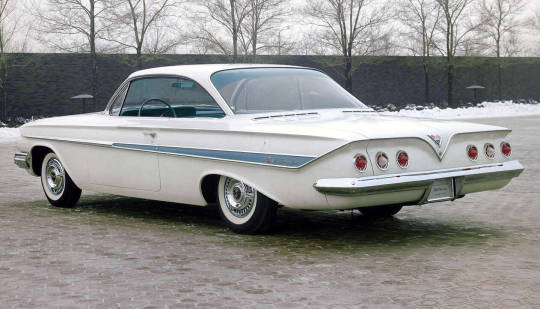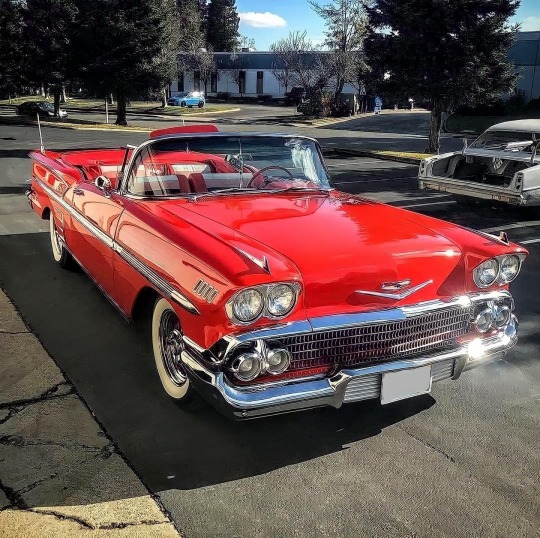#chevrolet impala sport coupe
Explore tagged Tumblr posts
Text

1964 Chevrolet Impala SS
#general motors#autos#gm#classic car#vintage automobiles#chevrolet#chevrolet impala sport coupe#impala#chevy impala
267 notes
·
View notes
Text

1961 Chevrolet Impala Sport Coupe
#Chevrolet Impala Sport Coupe#Chevrolet Impala Sport#chevrolet impala#chevrolet#Impala#car#cars#muscle car#american muscle
366 notes
·
View notes
Text



Chevrolet Spirit of America Impala Sport Coupe, 1974. The SoA Impala was available in white or blue and was made in an edition of 2500 cars
#Chevrolet#Spirit of America#Chevrolet Spirit of America Impala#Chevrolet Impala Sport Coupe#1974#pillarless hardtop#hardtop coupe#1970s#special edition#limited edition
167 notes
·
View notes
Text
‘67 Impala

#general motors#chevrolet#autos#chevrolet impala sport coupe#impala#chevrolet impala#vintageadsmakemehappy#vintage advertising#gm#classic car
67 notes
·
View notes
Text

Chevrolet Impala Sport Coupe (1959)
#cars#cool#cool cars#car#classic car#vintage#motor#classic#drive#driving#summer#saturday#weekend#holiday#chevrolet#sport coupe#midcentury#1950s fashion#1950s style#1950s vintage#decade: 1950s#1950s cars#1950s car#1950s
426 notes
·
View notes
Text

1959 Chevrolet Impala Sport Coupe
551 notes
·
View notes
Text

Chevrolet Impala Sport Coupe 1961. - source Amazing Classic Cars.
75 notes
·
View notes
Text






1962 Chevrolet Impala SS 409 Hardtop Sport Coupe
Issued by the Goldvarg Collection in 2022. It is 1:43 scale and crafted in resin. A Limited Edition, # 090 of 275. The model is finished in Anniversary Gold. GC 044D
7 notes
·
View notes
Text

Here are **five lesser-known facts** about the iconic **1960 Chevrolet Impala**:
### **1. Redesigned Tailfins**
The 1960 Impala marked a shift in Chevrolet’s tailfin design. Unlike the dramatic, "batwing" horizontal fins of the 1959 model, the 1960 Impala had more subdued, tapered fins. This redesign was part of a broader industry trend to tone down the exaggerated fins of the late 1950s, giving the car a sleeker and more sophisticated look.
### **2. The "X-Frame" Chassis**
The 1960 Impala utilized Chevrolet’s unique **"X-frame" chassis**, which debuted in 1958. This design eliminated traditional side rails in favor of an "X" structure for greater torsional rigidity. While it improved ride quality and handling, it also left the car more vulnerable in side-impact collisions, a point of criticism in later safety studies.
### **3. First Factory-Installed Seatbelts**
In 1960, Chevrolet offered **factory-installed seatbelts** as an option for the Impala for the first time. This was a significant move during an era when safety features were just beginning to be marketed, though many buyers still considered them unnecessary.
### **4. Rare Turbo-Air 6 Engine Option**
While most 1960 Impalas came equipped with the **Turbo-Fire V8s** (283 or 348 cubic inches), Chevrolet also offered a rare inline-6 engine, the **235 cubic-inch "Turbo-Air 6"**. Although the inline-6 was aimed at buyers seeking affordability and efficiency, it was uncommon in a car as stylish and performance-oriented as the Impala.
### **5. "Sport Coupe" and "Bubble Top" Popularity**
The **Sport Coupe** version of the 1960 Impala, often referred to as the "Bubble Top," became iconic among enthusiasts. Its unique roofline, with thin pillars and a massive curved rear window, offered a distinctive appearance and improved visibility. Though practical for its time, this design was replaced by a more squared-off roofline in 1961, making the 1960 version especially desirable today.
The 1960 Chevrolet Impala remains a symbol of early 1960s American car culture, blending style, innovation, and performance. Would you like details on its specs, value, or customization potential?
3 notes
·
View notes
Text

1967 Chevrolet Impala SS
#general motors#gm#classic car#chevrolet#vintage automobiles#chevrolet impala sport coupe#impala#chevy impala#impala ss#autos
572 notes
·
View notes
Text

1958 Chevrolet Impala Sport Coupe
219 notes
·
View notes
Text

1958 chevrolet bel air impala convertible
History, The Impala name was first used for the full-sized 1956 General Motors Motorama show car that bore Corvette-like design cues, especially the grille. It was named Impala after the graceful African antelope, and this animal became the car's logo. Painted emerald green metallic, with a white interior, the Impala concept car featured hardtop styling. Clare MacKichan's design team, along with designers from Pontiac, started to establish basic packaging and dimensions for their shared 1958 General Motors "A" body in June. The first styling sketch that would directly influence the finished Chevrolet automobile was seen by General Motors Styling vice president Harley Earlin October. Seven months later, the basic design was developed.
For its debut in 1958, the Impala was distinguished from other models by its symmetrical triple taillights. The Chevrolet Caprice was introduced as a top-line Impala Sport Sedan for model year 1965, later becoming a separate series positioned above the Impala in 1966, which, in turn, remained above the Chevrolet Bel Air and the Chevrolet Biscayne. The Impala continued as Chevrolet's most popular full-size model through the mid-1980s. Between 1994 and 1996, the Impala was revised as a 5.7-liter V8–powered version of the Chevrolet Caprice Classicsedan.
First generation (1958)
1For 1958, GM was promoting their fiftieth year of production, and introduced anniversary models for each brand; Cadillac, Buick, Oldsmobile, Pontiac, and Chevrolet. The 1958 models shared a common appearance on the top models for each brand; Cadillac Eldorado Seville, Buick Roadmaster Riviera, Oldsmobile Super 88 Holiday, Pontiac Bonneville Catalina, and the #Chevrolet Bel-Air #Impala.
The Impala was introduced for the 1958 model year as top of the line Bel Air hardtops and convertibles. From the windshield pillar rearward, the 1958 Bel Air Impala differed structurally from the lower-priced Chevrolet models. Hardtops had a slightly shorter greenhouse and longer rear deck. The wheelbase of the Impala was longer than the lower priced models, although the overall length was identical. Interiors held a two-spoke steering wheel and color-keyed door panels with brushed aluminum trim. No other series included a convertible.
The 1958 Chevrolet models were longer, lower, and wider than its predecessors.The 1958 model year was the first with dual headlamps. The tailfins of the 1957 were replaced by deeply sculptured rear fenders. Impalas had three taillights each side, while lesser models had two and wagons just one. The Impalas included crossed-flag insignias above the side moldings, as well as bright rocker moldings and dummy rear-fender scoops.
The standard perimeter-type frame was abandoned, replaced by a unit with rails laid out in the form of an elongated "X." Chevrolet claimed that the new frame offered increased torsional rigidity and allowed for a lower placement of the passenger compartment. This was a transitional step between traditional construction and the later fully unitized body/chassis, the body structure was strengthened in the rocker panels and firewall.However, this frame was not as effective in protecting the interior structure in a side impact crash, as a traditional perimeter frame.
A coil spring suspension replaced the previous year's rear leaf springs, and an air ride system was optional. A 283 cu in (4,640 cc) engine was the standard V8, with ratings that ranged from 185 to 290 horsepower. A "W" block (not to be confused with the big-block) 348 cu in (5,700 cc) Turbo-Thrust V8 was optional, producing 250 hp (190 kW), 280 hp (210 kW), or 315 hp (235 kW). The Ramjet fuel injection was available as an option for the Turbo-Fire 283 V8, not popular in 1958.
A total of 55,989 Impala convertibles and 125,480 coupes were built representing 15 percent of Chevrolet production. The 1958 Chevrolet Bel Air Impala helped Chevrolet regain the number one production spot in this recession year.
4 notes
·
View notes
Text
Chevy Chevelle - Iconic Muscle Car of its Era

One of the most versatile muscle cars of its era, the Chevy Chevelle first came off the production line in September 1963, introduced at a Chicago press conference. Built on an A-body platform, the Chevelle shared the same underlying frame as the Oldsmobile Cutlass, Pontiac Tempest, and Buick Skylark. Its niche was between the large Impala and compact Chevy II/Nova, and its nearest competitor at launch was the Ford Fairlane. The popular mid-size sold 338,286 units in its first year and remained in production until 1977.
Introduced as a 220-horsepower 283cid, the Chevelle was initially available as a two-door hardtop, the Sports Coupe, or a convertible. A smaller number of four-door sedans and two or four-door station wagon models also made it to showroom floors. One hallmark was that it returned the 115-inch wheelbase of 1955 to 1957 Chevys. This created a smooth ride that backseat passengers appreciated, making it a popular family vehicle. By the end of 1964, the Chevelle was available with a top-line 300 horsepower 327cid engine that solidified it in the performance category.
By 1965, Chevy offered a performance 350hp L79 engine on its Super Sport (SS) trim model. Innovations included vinyl bucket seats with a floor console, a four-gauge cluster, and an optional dash-mounted tachometer that measured revolutions per minute.
In 1965, Chevrolet upped the ante, introducing the Chevy Malibu SS 396 Z16. The Z16 replaced the small-block engine of previous SS models with a big-block V8 engine known as the 396 (or L37). This delivered a full-throated 375 horsepower and is seen by many as the start of the classic muscle car era. The Z16 is also one of the most sought-after models by vintage collectors, as only 201 of the new trim was manufactured in its inaugural year.
The popularity of the higher-performance Super Sport packages on the baseline Chevelle was such that in 1966, Chevrolet made SS its model, which featured a 396 engine and horsepower options between 325 and 375. This more limited version of the first-generation Chevelle, the SS396 series, lasted through 1968.
Spanning 1968 to 1972, the second generation of the Chevelle relegated Super Sport to an engine package again and represented a radical redesign of the vehicle. The 396 cubic inch, 375hp engine remained the top-of-line option. Aesthetically, the taillights were bigger, and the back of the vehicle was shorter and curvier. With a cut wheelbase, the second-generation Chevelle also featured a noticeably longer hood.
The 1970 Chevelle LS6 introduced the iconic twin racing-stripe front hood option, which is familiar from car chase scenes in movies and TV series of the era. Its taillights were bumper-mounted, and with a 450 horsepower 454 block, it had one of the most powerful engines of the era. The highly collected model only lasted a single year: already, United States regulations were on the horizon that would make better mileage vehicles a must, and in 1971, the vehicle returned to a small-block 350 engine.
The mid-1970s oil crisis and further fuel economy regulations stripped the Chevelle line of its power and luster. By 1977, the Chevrolet Chevelle and Malibu series had only 145 horsepower, a far cry from their muscle car heydays. The following year, the Chevelle was folded into the Malibu brand as Chevy streamlined operations.
0 notes



